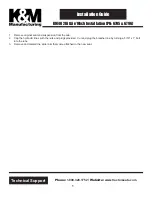
Immediate Dial, FXS, or Q.421 channel. This provides routing information as in DNIS operation
for the equipment under test, if needed.
Note:
Only in-band DTMF signaling is available. R1 and R2, MF signaling is currently not supported by
the TSP.
The format used for transmitting ANI and DNIS varies depending on how the equipment under
test is programmed. A
*
can be used in the Transmit Digits field to provide a separator between
the ANI and DNIS. A # can be used as the terminator. The following are two possible scenarios:
ANI*DNIS#
or
DNIS*ANI#
Where the total number of characters is 40 or less. Also, other variations are possible. Refer to
the user manual or the vendor manual of the equipment under test for more information.
Audio Message
The last option for
Channel Configuration
is
Audio Message.
Here you can choose an audio file to
be played during a call simulation. Voice Messages must be created and stored in mu-law or
a-law encoded, 8 bit WAV file format, and are stored in the PC in the Audio folder. Files can then
be downloaded into the TSP and stored in non-volatile memory. The TSP can play up to 8
seconds of a voice message per channel. Voice Message storage is limited to 24 seconds total.
The TSP will automatically convert a WAV file between a-law and mu-law in order to transmit
them in accordance with the unit’s port configuration.
The default for
Audio Message
is
NONE
. An audio file can be chosen by clicking the
Browse
button and choosing the preferred file. The speaker button will play the audio file chosen. If you
wish to have the message played continuously during the call, click the
Repeat
box to enable it,
otherwise the message will be played only once.
Note:
To download audio files, the TSP must have a network connection and a valid IP address
programmed.
Telecom Simulation Platform
Page 26
















































